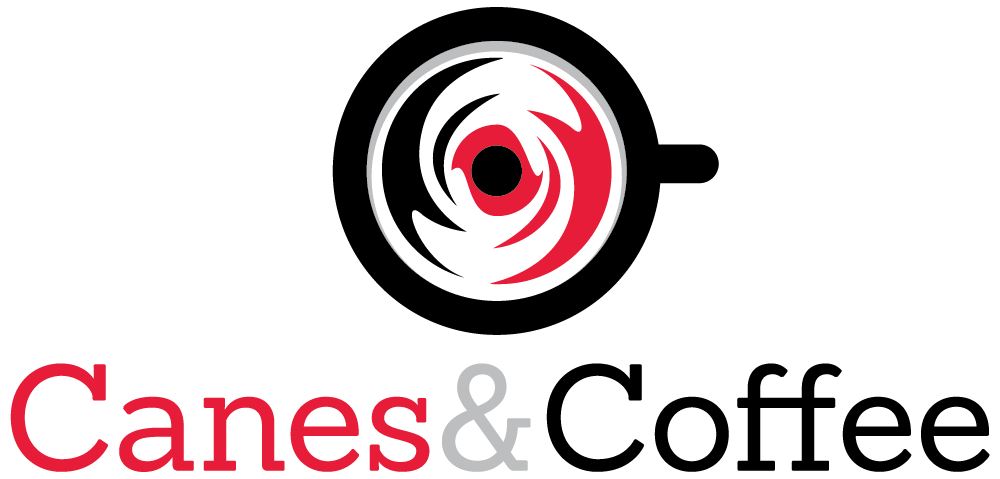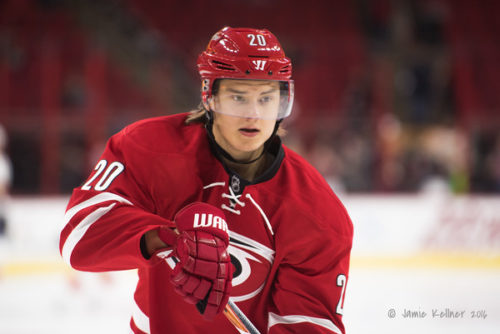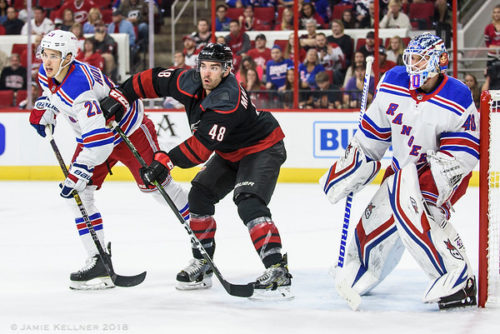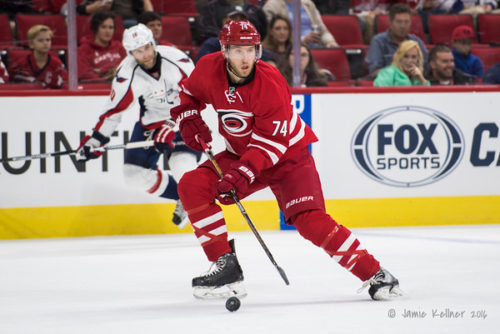After three days of goalie articles, Wednesday’s Daily Cup of Joe offers a reprieve for those who are sick of goalies and/or just prefer to roll with Petr Mrazek and James Reimer again (which is not a bad option).
Today’s article details the team’s near (or completely?) perfect record of decision-making as relates to parting ways with higher-end players since Tom Dundon bought the company and Don Waddell took over as general manager.
The list
The focus here is higher-end players, so I will include some players who were either prospects or bottom half of the roster players.
Noah Hanifin
In a draft with a ton of talent at the top end, Noah Hanifin came touted as a can’t miss as the fifth overall pick in the 2015 NHL Draft. Upon arrival, one could quickly see why. Hanifin had size and the capability as an 18-year to skate the NHL game. He was not a difference-maker as a third pairing defenseman at the NHL level as an 18-year old, but he figured to take strides rapidly and grow into the ceiling that his physical abilities afforded him. But the issue was that that never really seemed to happen. When he completed his entry-level contract with the Hurricanes, Hanifin was still every bit of a third pairing defenseman who was trying to learn/develop his way up to a higher level. He just made too many mistakes and still struggled with decision-making/sorting things out at NHL speed. But by virtue of his potential and the draft pedigree that often overprices players in their second contracts, Hanifin was due a big raise. Instead, the Hurricanes packaged him up with Elias Lindholm to return Dougie Hamilton, Micheal Ferland and prospect Adam Fox. Calgary signed Hanifin for six years at $4.95 million per year. Now five years deep into his NHL career, Hanifin is still a player whose hoped for ceiling significantly exceeds his current level of play. The Hurricanes netted Dougie Hamilton in that deal, but more basic than that, I do not think Hanifin would be worth the $4.95 salary as a free agent.
Elias Lindholm
In that same deal that saw Hanifin depart, the Hurricanes included Elias Lindholm. Even more so than Hanifin, Lindholm was rushed to the NHL level and spent his entry-level contract learning more so than providing value on an inexpensive contract. After playing out a bridge contract, Lindholm was due a sizable raise. Rumors and rumblings had him maybe asking for more than what the Canes would offer which played a role on him hitting the trading block. Like Hanifin, Lindholm was signed by Calgary to a six-year deal earning $4.85 million per year. Lindholm fit well on Calgary’s top line posting 78 points in 81 games for the 2018-19 season and a bit less in 2019-20 with 54 points in 70 games. The Hurricanes did get a good return for Lindholm, but he does qualify as a departure who has played well and produced since leaving.
Jeff Skinner
Though trading Lindholm and Hanifin preceded the decisions, the big decision points before the 2018-19 season for the new regime were Jeff Skinner and to a slightly less degree Justin Faulk. Skinner was the more pressing decision with only one year remaining on his contract. Much to the chagrin of the part of the fan base loyal to Skinner, he was traded for what amounted to a collection of random pieces. Many cried that the Canes did not get enough in return, but Skinner’s no-trade clause had him holding all the cards such that the team had to collect what it could if it wanted to move on. In Buffalo, he started fast which resulted in a decent 63-point 2018-19 season, but in thesecond year of his eight-year contract that pays him $9 million per year until he is 35 years old, he fell flat. His scoring sank to a meager 23 points in 59 games and the horrid even strength goal differential that haunted him in Raleigh arrived in Buffalo. The skill level is there for a rebound, but right now the 6 years remaining at $9 million per year looks scary.
Cam Ward
Another quick decision was to part ways with franchise goalie Cam Ward after 13 years. The move seemed like a no-brainer, but remember that he had had his ups and downs for multiple years but always landed in the #1 goalie slot. Ward posted sub-par numbers in his one season in Chicago and then retired.
Micheal Ferland
Acquired only a year earlier, Micheal Ferland became a free agent after the 2018-19 season. In his lone campaign in a Hurricanes jersey, Ferland definitely filled a role. He meshed nicely on Aho’s line in the first half of the season bringing a power forward skill set and some finishing. But the second half of the season saw Ferland sidelined with recurring concussion issues and not nearly as productive on the score sheet. After keeping him as a self-rental at the trade deadline, the Hurricanes opted not to re-sign him when he became an unrestricted free agent at the end of the season. He signed a three-year deal for $3.5 million per year with Vancouver and then proceeded to have his season shortened to a mere 14 games by another concussion. Despite the modest salary and term, the remaining two years at $3.5 million per year now looks higher on risk than potential reward.
Calvin de Haan
Also from the category of players who definitely contributed to the Hurricanes return to the playoffs but exited the 2018-19 season with heightened injury risk was Calvin de Haan. De Haan played a significant role making the Hurricanes blue line a significant strength during the 2018-19 season. He paired with Justin Faulk in the second pairing to start the year. Faulk deserves credit for his own play obviously, but I also think it is fair to say that de Haan was part of Faulk taking a significant step up from the prior year. But in the playoffs de Haan suffered a recurring shoulder injury that would have him returning to play barely to start the 2019-20 season. Rather than take the risk, the Hurricanes instead opted to trade de Haan. A bit like the Skinner trade but on a smaller scale, the return was not great indicating that this was a conscious decision by Canes management to part ways. De Haan suffered another shoulder injury and played only 29 games in the 2019-20 season before being sidelined for the rest of the regular season. As with Ferland, the Hurricanes decision to decrease exposure to injury risk paid off.
Justin Faulk
In my opinion finishing what the team (in my opinion) tried to do the prior summer, the Hurricanes talked a bit about being willing to re-sign Faulk under the right terms but ultimately traded him to the St. Louis Blues. In his first year with the Blue and the last year of the contract that he left with, Faulk was ‘meh’ in a Blues uniform. After a run of six straight years with 30 or more points, Faulk’s scoring dipped to a meager 16 points in 69 games. He also had an up and down year defensively. On the heels of his ‘meh’ 2019-20 campaign, Faulk is just now starting the first year of his seven-year contract that will pay him $6.5 million per year until he is 36 years old. Hard to imagine he would garner that contract as an unrestricted free agent this summer.
The results so far
When one totals it up, the team made decisions to part ways with seven significant players in the span of two off-seasons. That is in addition to managing to trade out of contracts for Victor Rask and Scott Darling who were underperforming. It is too early to make final declarations on all of these situations, but as of right now the only player that I would want back on his current contract is Elias Lindholm.
Whether it is Don Waddell’s instincts after years of experience or Eric Tulsky and his team crunching numbers on risk/reward and possibly pushing the team to be willing to part ways when the value does not match the salary cost, the Canes have been good at reducing injury risk and/or avoiding risky contracts.
What say you Canes fans?
1) Were you aware of how good the team’s track record has been in these decisions at this interim checkpoint?
2) Do you agree that Elias Lindholm is the only player that would be worth taking back on his current contract?
3) What is your wild guess for process for these decisions? Do think these were just a series of good one-off decisions primarily by Waddell? Or do you think maybe Tulsky is playing a significant role in evaluating contracts for risk/reward and pushing the team to unload even good (or at least potentially good) when the price is nor right?
Go Canes!




Avoiding overpaying aging players should in chapter one of a “General Managers for Dummies” book. Chapter two would be “if you do sign an aging player, limit the term or run away.” The
This is also all evidence that Canes aren’t going to blink to trade Hamilton if his agent wants max dollars/term on this next contract. We’re all hoping that Dougie will take a discount to stay in Raleigh and I think he would if presented the right offer. But also, his idea of discount might be very different from Waddell/Dundon’s idea.
As far as the “GM for dummies” book the Canes failed when signing Gardiner to four years at $4M.
As much as I was not a fan of some of these trades at the time, (and I still think we could’ve gotten more in return, especially for Skinner), I do admit that, by luck or by calculation, the Canes mostly came out on top.
I wonder what went wrong with Hannifan, he was such a concensus top 5 prospect, but he never put it all together, also reflect badly on Ron Francis first round drafting.
I’d still rather have Faulk than Gardner + Skjei (assuming the Canes could’ve negotiated a 5.5 m deal, something we will never know).
Ward was definitly an overated goalie for the last 2 or 3 years of his career, an example of Rutherford’s overly generous contract handouts (Staal was the other, as good as Staal was, being paid as much or more than Crosby never made sense).
And while the Canes parted with the right players, they have almost nothing to show for it (most return pieces have already left for free or turned into low round draft picks).
Hamilton is the one eception if a compromise can be found, he’s a Caniac, we know it, he knows it.
I’m not the biggest fan of Ron Francis as a GM, but I don’t blame him for drafting Hanifan. He was the consensus best defenseman in the draft. Would have taken stones to pick Provorov instead, especially given that administration’s dislike of Russian players. An example of how scouts can get all ga-ga over a big man that skates pretty.
Not having Jeff Skinner in your lineup is the reward. He is a talented goal scorer, but awful at most everything else. Bad hockey player. That contract may be as bad as the deal Semin signed with Rutherford.
The story was that the final negotiation session on the Friday morning before draft day ended in acrimony. The difference might have been <1M (and might have some term difference) but we were not going to pay his ask. Same with Hanifin and Faulk – we weren't going to pay their respective asks. I think that was less fancy stats based and more just dollars and sense. Lindy and Hanifin had reached the threshold where their ask was greater than their worth as a player and Faulk would have been a cap-buster and not worth the big dollars over term. These are hard-nosed business decisions and sound ones.
Ward was a given – and he got a chance for one more year, and I am glad the organization welcomed him back so warmly with his retirement – but this was his better days were behind him and we needed a fresh start in net.
de Haan was a classic cap-dump in anticipation of Aho's imminent offer sheet – avoiding risk because of his shoulder was secondary.
So I am seeing all of this as pure hockey decisions/trades.
The Skinner deal was just pure crazy, not sure why the Sabres were willing to pay that much (good for him).
The Rask trade unfortunately turned out to be for a similarly priced and equally unproductive forward (after the initial spark), so the Canes did not come out on top there necessarily, though it was fun to watch Nino tear it up between coming to Carolina and the playoffs. I also would not put Rask in the same category of under performing as Scotty Darling. Finding a way to turn him into Reimer was an absolute Wandell masterpiece.
.
We don’t get Hamilton if we don’t give up Lindholm, but he is the exact type of player we’re really looking for right now. If we lose Dougie after next year, it was probably still worth the trade to change the trajectory of the roster, but it will sting a little.
I tend to agree with raleigh on the rest of it: generally easy decisions to make with players who didn’t fit into our future plans. To GMDW’s credit, he made the decision and acted on it.
As for Hanifin, forget Provorov; how about Werenski or Meier or Rantanan or Kyle Conner or DeBrusk or Chabot or Boeser or Konecny? You could have thrown a dart at the board and would have more than likely wound up with a very solid player, one that would up doing better (at least until now) than the one we drafted. That draft year was very strong.
Hannifan is an OK pick most years, basically an average 2nd pair D-but that was a strong draft. At the time there wasn’t very much criticism of the pick. Getting Rantanan would have been great and you didn’t even mention Barzal or some kid named AHO.
Nino payed a big role in the canes making last the playoffs and plays pretty hard even when not scoring. Much better than having Rask.
Skinner was addition by subtraction.
I wouldn’t give Faulk much more than Gardiner got and not more than 4 years. Would rather have Edmundson at his new contract than Gardiner, Faulk or Skjei with their contracts.